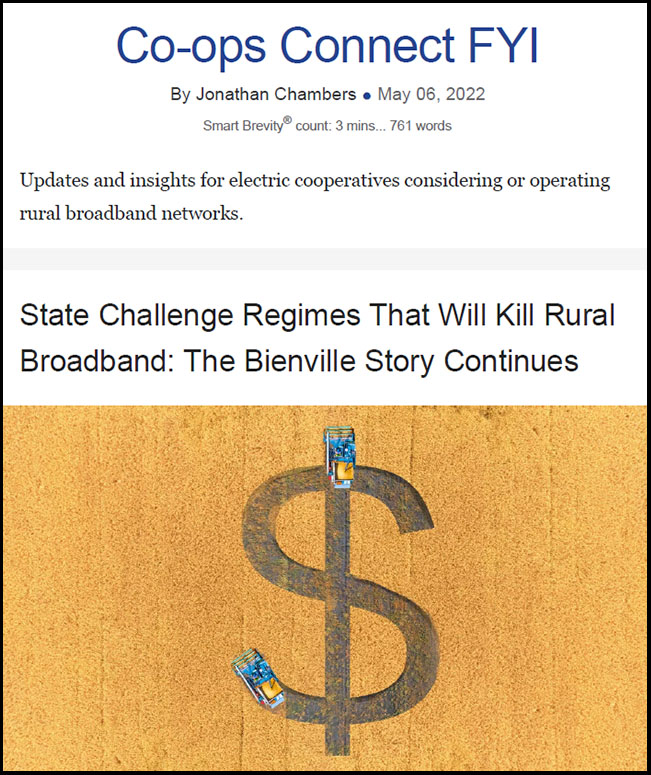State Challenge Regimes That Will Kill Rural Broadband: The Bienville Story Continues
May 6, 2022
A brief recap:
Bienville Parish, Louisiana, is a persistent poverty county, located in one of the poorest areas of the country.
According to NTIA, Bienville Parish is also woefully underserved in terms of broadband.
What we’re doing about it:
Last year, we applied to the Louisiana Office of Broadband Development and Connectivity (OBC) for $3.4 million to build a fiber network in Bienville.
- As evidence that the areas are unserved, we submitted NTIA’s data and the sworn statements of 400 residents.
Yes, but: The application was protested by a cable provider, which offered as proof of broadband availability maps with addresses and census blocks ... but no speed tests and no independent verification.
The state broadband office weighed the evidence.
- On one hand, speed test data and maps provided by the federal agency charged by Congress to allocate $42.45 billion on rural broadband, and the sworn statements from 400 members of the community.
- On the other hand, self-reporting by an incumbent.
Surprise: The broadband office went with the cable company.
- The Commissioner for Administration in the state of Louisiana reviewed the broadband office decision and found that the record “is not sufficient for me to conduct an adequate appellate review of OBC’s decision. The record does not include OBC’s methodologies employed, and lacks specificity...Moreover if conflicting data has been submitted, OBC should explain how and why some sources of data were deemed more reliable than others.”
The Impact of the Bienville Parish Decision
Go deeper:
Of course, the broadband office’s decision is important to the residents of Bienville. But the implications are broader:
- In an application for only $3.4 million in one of the most deserving parts of the country, it has taken six months to get to this point.
- This point is a denial of sufficient broadband funding, which had to be appealed.
As Infrastructure Act programs are prepared state by state, imagine this one example playing out over and over again across the country.
- To spend $42.45 billion as a nation, are we going to have this fight 10,000 times over?
Even states that use their own maps to identify eligible areas permit challenges.
- Just this week, we received notice of challenges to applications in Kentucky, even though we used the Kentucky maps.
- The Kentucky broadband office has asked us to provide evidence that its own maps are correct.
Meanwhile, NTIA and every state must wait for the FCC’s new DATA maps.
- These maps will be based on more granular self-reported data.
- They will be just like the current FCC maps, but worse. Now disputes will occur at the service address level, rather than the census block.
Why it matters:
Since neither federal nor state agencies will stand behind their own maps, what’s the point of the maps?
Unless NTIA, the FCC, and the states adopt a systematic challenge process, incumbents will have every incentive to challenge every application.
And broadband offices will be overwhelmed.
A Different Approach to Determine Eligible Areas for Public Funding
Neither NTIA nor states have to wait for the FCC to produce maps of eligible areas. I have two suggestions.
- NTIA and/or states should publish a list of areas eligible for broadband funding based on ISP data and corroborated by speed tests.
- States may permit challenges to the list provided such challenges to an eligible area be accompanied by speed test data that follow the FCC’s speed test protocols.
Why FCC speed test protocols?
- Recipients of Connect America Funds or Rural Digital Opportunity Fund must demonstrate compliance by providing speed tests.
- There are protocols for these tests, developed over years of work by the FCC’s Office of Engineering and Technology.
- The protocols are well-known by the industry and are standard industry practice.
The Bottom Line
Most telecommunications companies already use the FCC’s speed test protocols. If an applicant has used NTIA, FCC, or state broadband data that identifies an area as unserved or underserved, there should be a presumption that the data is correct. A challenge to that application should include more than an assertion of service.
Companies must participate in the FCC’s testing protocols to receive public funds in rural areas. If a company wants to deny funding to an eligible rural area, why not require the same testing protocols?

